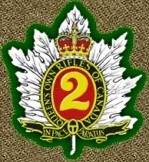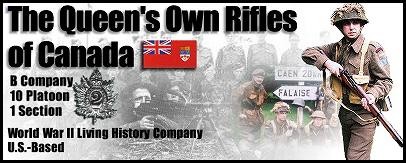Battledress Blouse:
WW II Canadian pattern (1950's pattern not allowed). Also permitted, postwar Belgian or Greek Blouses if cut and color is the same as Canadian ones. The unit can supply titles and division patches. Trade & qualification badges as well as medal ribbons are governed by unit policy- check before you put any on your blouse. Larger sizes are harder to find and more expensive. Check with one of our members to determine the approximate Commonwealth size you will need.
Battle
Trousers: WW II Canadian pattern (1950's pattern is allowed if a dressing pocket is professionally added). Belgium or Greek Trousers are permitted if cut and color are the same as Canadian. DO NOT wear war dated trousers into the field ( They are too rare and expensive) Two pair of trousers are recommended.
Shirt:
Canadian or British WW II pattern. US Army WW II enlisted
men's shirts are also permitted. Two shirts are a must. Easy to find. Relatively cheap.
GS
Beret: WW II Canadian Pattern. Beret is worn with a Regimental Cap Badge and approved badge backing. Can be a bit hard to find now, but the unit often finds them and sells them to members.
Suspenders:
WW II Canadian Pattern. Elasticized 'Y' design, in khaki or tan color. Postwar suspenders are identical to wartime ones.
Under
drawers: Any WW II Allied Pattern. Summer weight T-shirts must be V neck style. Surprisingly, war dated underwear is pretty common and low priced, so get several sets.
Ammo
Boots: WW II Canadian Pattern. Over the ankle style with 7-8 lace holes. Leather soles with hobnails as well as toe & heel plates. Modern Canadian Forces "Parade Boots" are very similar to the WWII pattern. However, they will need to have leather soles and hardware added. Two pair of boots are recommended. DO NOT wear war dated boots. Third Division or buckle boot replicas are hard to find, but we may have found a source for decent replicas in Holland. However, all members must have at minimum ankle boots even if buckle boots are found.
Socks:
Gray wool, calf length. War dated socks are very rare. If you find a pair DO NOT wear them. Check your local surplus store or outdoor clothing supplier for gray wool socks. Du-ray brand, made in Canada, is the best. Several pair of socks are needed, particularly at field events.
Gaiters:
WW II Canadian Pattern. These are plentiful and cheap. Each member is required to have 2 pair, one for field use and one for walking out. Easy to find and cheap.
Face Veil: Camo item. Easy to find. Postwar ones are generally what is used.
Denims: This is a lightweight, green uniform that was made to be a coverall for the wool uniform. We also use it by itself at particularly warm events. Postwar (1950's) Brit uniforms are ok. Some reproductions are being made but check with the unit before purchasing.
Denison smock: This over smock
is generally thought to be the sole province of the airborne troops. Not true. We have a lot of pictures of QOR wartime members in denison smocks during the winter of 1944-45. For our members, it is an OPTIONAL item, but a nice thing to have. Originals are rare and expensive and should not be worn.
Leather Jerkin: Safest thing is to get a Belgian version which is readily available. The brass buttons must be replaced with large, flat black or brown plastic ones.
String
Vest: To wear under your shirt, these are available from a few vendors. A cold weather event item.
Five-finger Brown-wool
Gloves: The old-timers have a source for these. Trigger finger British mittens are acceptable to start with.
Wool Cap Comforter: British pattern
Enlisted Man's Great Coat (or
overcoat): Expensive and hard to find, and an optional item. Both the early war (single-breasted) and late war (double-breasted) are acceptable. Must be Canadian and must have proper war-time buttons.



